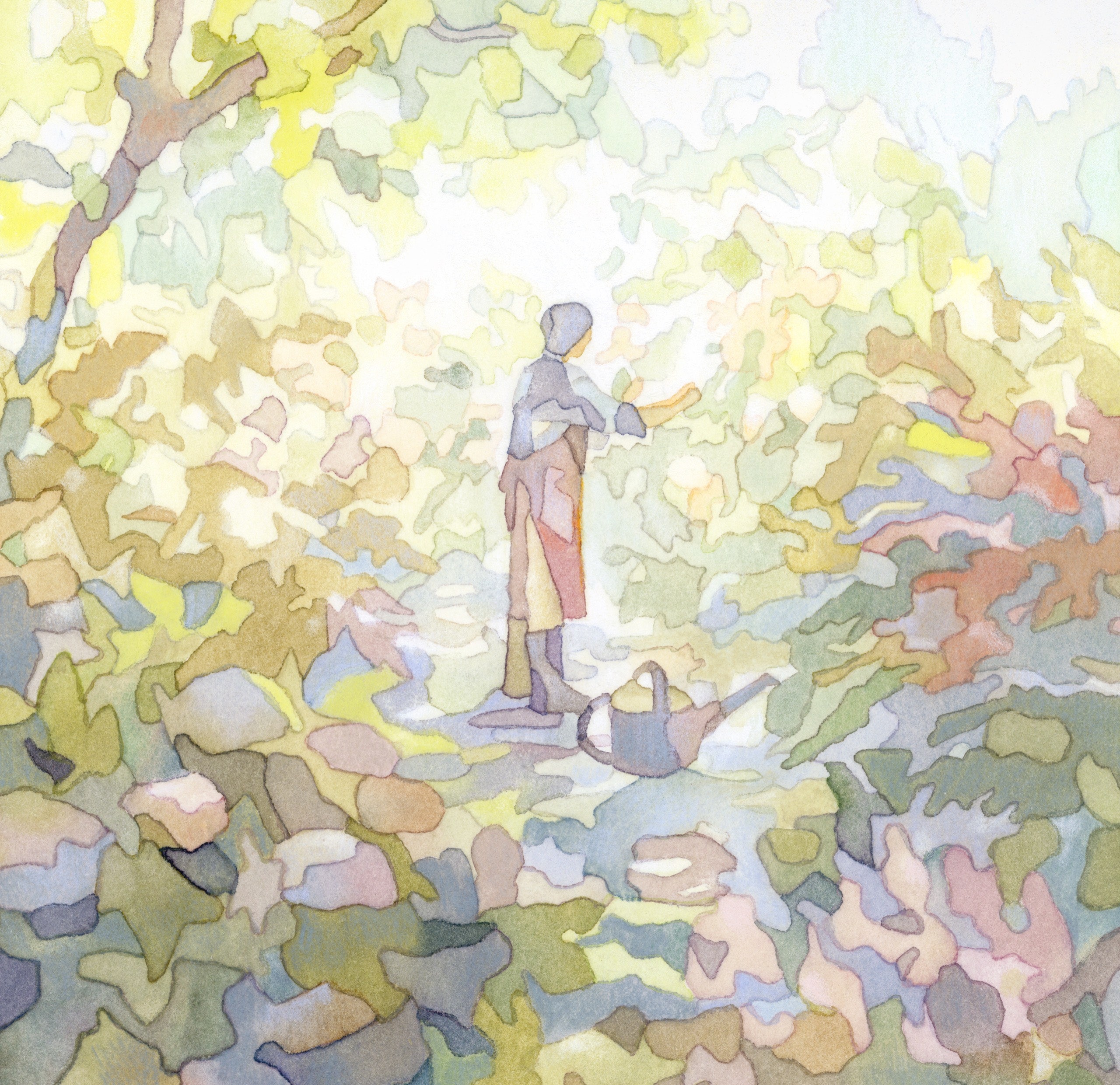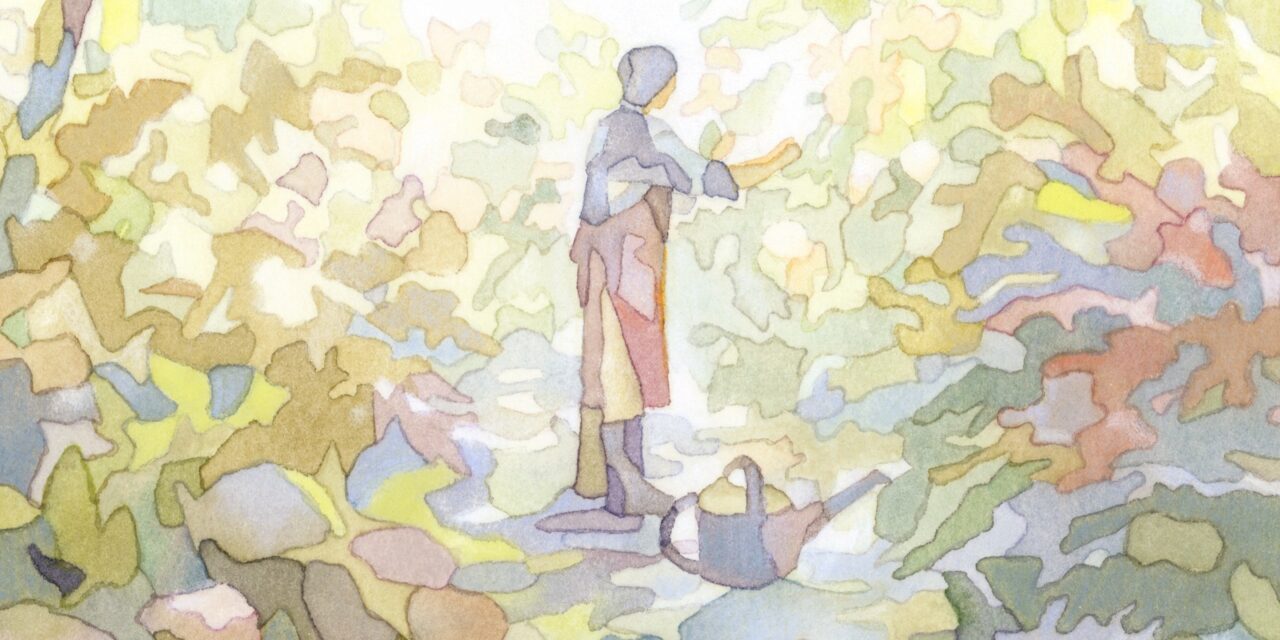What Gardening Offered After a Son’s Death

“It’s rather vexing, isn’t it, not to know what flowers will come up next year?” I said to my friend Brigid, in a voice that sounded more like a character’s in a novel than my own. It was November, 2017, and my family had just moved into our house in Princeton. The trees were shedding their leaves, in a theatrical manner that was new to us—we had relocated from California to the East Coast four months earlier.
“There are some roses,” Brigid said. “Those look like lilies.”
“And those are hostas.”
There were six or seven rose bushes, with residual flowers, fuchsia-colored, shivering on top of the near-leafless branches. Lilies and hostas, their leaves already paled and half rotted by the cold autumn rain, remained recognizable. The rest of the garden was a wilted mystery, buried under fallen leaves.
I was not a character, but I was speaking like one for a reason: I was pondering a set of characters. I went on and told Brigid about a moment in “The Saga of the Century Trilogy,” by Rebecca West, about a British family living in London in the first half of the twentieth century. The eldest daughter in the family, Cordelia, newly wed, has moved into a pretty house in Kensington; when she has her two younger sisters over for a visit, she frets, with the leisure of a young woman married into respectability and stability, about not knowing whether the hawthorn tree in her garden will bear white, pink, or red flowers in the spring.
A few chapters later, the hawthorn tree blooms. By then, the little brother of the family, Richard Quin, still a teen-ager, has been killed in the Great War, ten days after arriving in France. “Killed, not missing?” Cordelia cries out in agony when she’s told the news. The hawthorn tree outside reveals the answer to the riddle from the winter before: the flowers are red.
It is a quick stroke in a trilogy. The first time I read it, I did not fully register the weight of the detail. But, moving into a house in the fall, studying a garden that would remain unknowable for the moment, I went back and reread the few paragraphs about the tree.
Richard Quin, in West’s trilogy, is killed in the same manner that one imagines Andrew Ramsay is killed in “To the Lighthouse”: “[A shell exploded. Twenty or thirty young men were blown up in France, among them Andrew Ramsay, whose death, mercifully, was instantaneous.]”
For all we know, Richard Quin might have died next to Andrew Ramsay, in a pair of Virginia Woolf brackets.
Some days, that pair of brackets of Woolf’s continue to baffle me. Other days, they feel just right. The predicament when writing about a sudden, untimely death: the more you remember, the more elusive that death becomes. A sudden, untimely death is a black hole, absorbing all that you can give, not really clamoring for more. Though is a black hole ever to be fully filled so that it can cease to be one? Has anyone been able to define, capture, or even get close to a black hole?
[In September, 2017, our older son, Vincent, died by suicide, at sixteen.]
[On that day, we put down the deposit for the house. Deposit, death, in that order, four hours apart.]
In a novel, I would never have put the two happenings on the same day. In writing fiction, one avoids coincidences like that, which offer unearned drama, shoddy poignancy, convenient metaphor, predictable spectacle. Life, however, does not follow a novelist’s discipline. Fiction, one suspects, is often tamer than life.
Some fiction is tamer than some life, I should amend. And I confess that this is only a variation of a statement made by another character in “The Saga of the Century Trilogy,” who, upon discovering her husband’s extramarital affair, reads “Madame Bovary” and exclaims, “But art is so much more real than life. Some art is much more real than some life, I mean.”
A couple of months after Vincent died, a colleague asked me where I was “in the process of grieving,” assuming, I supposed, that there would be, and should be, a conclusion of mourning at some point. That phrase struck me as inaccurate; she might as well have asked me where I was “in the process of living.”
There is, alas, not a normal course of life, against which deviations can be measured and, hopefully, corrected. Only changed courses, altered lives. One can look longingly at the alternatives: Vincent graduating from high school (as our younger son did this summer) or graduating from college (as Vincent’s old school friends will next year), but alternatives belong to the realm of fiction. To paraphrase Elizabeth Bowen, the great Anglo-Irish writer, good fiction is good because it offers “the palpable presence of the alternatives.” In life, that presence can be palpably felt, but too much preoccupation with the alternatives may lead to a dilemma of either/or; even, neither here nor there. “Dilemma,” from its Greek etymology, means two lemmas: double assumptions, double propositions. But death is definitive; death does not lead to a dilemma.
I think about the alternative lives of my characters all the time. But, as I did not live in fiction, I decided, soon after Vincent’s death, to stop pondering the alternatives. What if belongs to fiction; what now, to this real life.
What now, in the last months of 2017: I could not read fiction. It was not a problem of mental focus. I spent hours every day reading Shakespeare’s plays and Wallace Stevens’s poems—all of a sudden, those words were the only ones that made sense to me. But if I stopped reading fiction would I ever be able to write fiction again? I was in the middle of a long novel. Forging ahead or scrapping the project felt equally impossible. Anguished, I looked up “anguish” in the O.E.D., to make sure that I was using the right word to describe my situation, and, indeed, it was an apt word choice. Etymologically, “anguish” comes to us from the Latin angustia—narrowness, lack of space, narrow space, narrow passage, strait, limitations, restrictions, confinement, imprisonment, restrictedness, shortage, scantiness, critical situation, narrow-mindedness, pettiness.
A black hole takes all and gives back naught. The anguish from a sudden, untimely death has a narrowing effect: alternatives are lost; space in the mind, too.
On her next visit, Brigid brought me two books. The first was “Onward and Upward in the Garden,” a collection of fourteen essays by the former New Yorker fiction editor Katharine S. White. The essays were originally published, in a span of twelve years, in the magazine, ostensibly as reviews of nursery catalogues. The other book was “Two Gardeners: A Friendship in Letters,” a collection of correspondence between White and Elizabeth Lawrence. Lawrence was a gardener and a gardening writer in North Carolina, and the friendship began when Lawrence wrote a fan letter to White after reading her first essay, “A Romp in the Catalogues,” in the March 1, 1958, issue of The New Yorker. For a year, they were “Mrs. White” and “Miss Lawrence” to each other, and then they became “Katharine” and “Elizabeth.” They would write to each other for the next nineteen years, until White’s death, in 1977.
Through the winter, I read the two books, very slowly. There was no reason to hurry, as that first winter was a long one; cold, snowy—cold and snowy for recent transplants from California, in any case. Day after day, I looked at the bare limbs of the trees, brownish gray, and the stale snow covering the garden, grayish white. I thought one afternoon, What if spring never returns? Right away I recognized the illogic and the melodrama of that thought. I had at my hand the words of two gardeners of yesteryear, books that had taken years to be written. Were these words not enough evidence that spring always comes, if not now, later?
[That winter, I often returned to Marianne Moore’s words: “If nothing charms or sustains us (and we are getting food and fresh air) it is for us to say, ‘If not now, later,’ and not mope.” Incidentally, it was Moore who may have first suggested that White should collect her reviews of garden catalogues into a book.]
Not to mope, I thought, was a proper goal: it would take all my energy and all my vigilance, and it was attainable. White’s essays and the letters between White and Lawrence were just right for that aspiration. The two women (and likely some of the gardens and many of the plants that they had written about) were no more, and yet their words remained and sustained, offering facts and opinions, gardening tales and personal woes, seasons and years, illnesses and deaths—all there, ready to distract me.
For instance, there were the names of plants to learn. In both books, I encountered many names, some familiar, others unfamiliar, and every one of them—even the most common, like “peony” or “lotus” or “fuchsia”—required investigation. Unlike Lawrence, I’m not a purist when it comes to botany, and I don’t always look up the Latin names for the plants. But I do like to know the etymology of their English names. And what one can learn just by going to the dictionary! “Peony” goes all the way back to ancient Greek: Paieon, or Paeon, was the physician of the gods. (What afflicts the gods? Possibly what afflicts us mortals.) “Lotus” comes from the Greek lōtos, a mythical plant bringing forgetfulness to those who eat its fruits. (I have eaten my share of lotus seeds, a delicacy in Chinese cuisine, without achieving oblivion.) “Fuchsia,” a word I often misspelled as “fuschia”—what mythical story accompanies thee? It turns out that fuchsia was named for the sixteenth-century German physician and botanist Leonhard Fuchs, whose name gave birth not only to that of the flower and that of the color but also to the nickname, Fuchsienstadt, for his home town of Wemding, where there is a pyramid made of as many as seven hundred fuchsia plants. And yet Fuchs never saw the flower fuchsia in his lifetime: it was discovered in the Caribbean and named by the French botanist and monk Charles Plumier, who was born a hundred and forty-five years after Fuchs. What led Plumier to name the flower for Fuchs? One can ask the question, but any speculation would be closer to fiction, just as peony was once the physician of the gods and lotus would bring forgetfulness.
Nearer our time—nearer than Fuchs and Plumier—were the horticulturists, seedsmen, growers, some older than White, others her contemporaries, behind those nursery catalogues which were once scrutinized by her. “They are as individualistic . . . as any Faulkner or Hemingway, and they can be just as frustrating or rewarding,” White wrote. And what a great joy to get to know the Faulkners and Hemingways of the nursery world through her words. Signing off for the catalogue of White Flower Farm was one Amos Pettingill. “I have no idea whether Amos Pettingill is a real person—the name sounds like an ill-advised fabrication,” White observed. Real or not, the name alone, I thought, was enough to send one’s imagination on a detour to Dickens-land. In the catalogue of White Flower Farm, Mr. Pettingill claimed that its French Pussy Willow was “not the unreliable wild Pussy Willow,” which led White to protest, “What is unreliable, pray, about the native wild pussies? I have found them trustworthy in every respect.” David Burpee, the president of the W. Atlee Burpee & Company, campaigned to have the marigold recognized as the national flower of the United States. White, describing “David Burpee’s one-man lobby,” noted, “I was also pleased as well as entertained, a couple of years back, when Mr. Burpee in person went to Washington, bearing marigold boutonnières for the legislators, and, at a Congressional hearing on naming a national flower, faced down the Senatorial proponents of grass, the corn tassel, the rose, and the carnation.” (Mr. Burpee did not succeed; the rose prevailed to become the national flower.)
To catch a glimpse, in White’s essays, of these men and women who once lived in their gardens, cultivating, hybridizing, dreaming of colors and shapes and scents that would catch their fancy, and then turning their obsessions into words, hoping that their catalogues would catch the fancy of many gardeners’ hearts: there is nothing narrowing in the world of roses, dahlias, marigolds, tulips, daylilies, and chrysanthemums. They were not black holes but rabbit holes.
And, of course, there were White and Lawrence, knowledgeable, opinionated, delighting in miscellanies. In her first letter, Lawrence recommended that White write about Cecil Houdyshel’s catalogues (which always opened with “Dear Floral Friends”): “I think he is in his nineties now, so you had better hurry.” In reply, White confessed, “I am always nervous when I write about old people.” Both women saw a garden writer in Lewis Carroll. In her first New Yorker review of nursery catalogues, referring to the card gardeners painting roses in “Alice’s Adventures in Wonderland,” White wrote, “Lewis Carroll was prophetic; today the garden men are quite as busy changing the colors of flowers as they are changing their size and shape.” A year later, Lawrence wrote in a letter, “If I have to hear flowers talk, I would rather read Through the Looking-Glass, which is my favorite garden book.”
[Their conversation led me to reread “Alice’s Adventures in Wonderland” and “Through the Looking-Glass,” the first fiction I read after Vincent’s death. The books, of course, have less to do with the missed or lost alternatives; instead, they make perfect nonsense out of the alternatives.]
After we moved into the house, I ordered twenty-five hyacinth bulbs (Delft Blue) and buried them haphazardly in the corners where I was certain that they would not interfere with any existing plants. Twenty-five, in retrospect, was a touchingly small number—a gesture rather than a plan, a prelude to a dream rather than a dream realized. But a gardener, like a writer, must start somewhere. (Last fall, I planted eight hundred bulbs; the fall before, seven hundred.)
Because of those twenty-five bulbs, garden catalogues began to arrive. One could be realistic: it had taken little time for one’s address to be shared among the nurseries. One could also be romantic: imagine that tentative order of bulbs as a small bugle, announcing a budding gardener. The catalogues, though radically improved graphically from the ones reviewed by White, still bore the same names: White Flower Farm, Wayside Gardens, Park Seed Company, W. Atlee Burpee & Company, and several more. I perused the catalogues as I imagined White and Lawrence had done; although new to this literature, I had yet to cultivate my tastes and form my opinions.
It occurred to me one day that no one had made a catalogue of gardeners: professional gardeners, who might be like important cultivars, bearing poetic or eccentric names; amateurs, akin to common carnations and cornflowers; and those, like me, who were gardeners only in their fantasies. Such a catalogue, abundant with human stories, would be amusing to read, no? I then realized that I was, true to my profession, fictioneering again.
When I was growing up, in Beijing, my family lived on the ground floor of an apartment block, so we were lucky to have a tiny lot, about two metres by 1.5 metres. My father, who had come from poor peasant stock, gardened judiciously: a grapevine that produced very sweet grapes (often pillaged by the wasps), our favorite green beans (which bore the name “pig ears”), loofahs (good for soup when the gourds were young and tender; when they were old and fibrous, they made the best kitchen scrubs), a honeysuckle plant (dried honeysuckle flowers can be used as medicinal tea). One year, when I was four or five, he planted some potatoes and described to me the unforgettable flavor of new potatoes. The only other time I have heard such a rapturous description of new potatoes was from an Irish poet in Cork.
My father did not garden for beauty. Some years, he would plant a cluster of impatiens, which he called “fingernail flowers” because, in the old days, the pink and red petals had been used when painting girls’ fingernails. The only constant floral decorations in our garden were the morning glories, self-seeding and wildly vivacious. Once, two women laughed at our garden to my face, dismissing my father as a lazy gardener who grew flowers that were no more than weeds. I was too young and too intimidated to defend him: he was a nuclear physicist, but he also did all the grocery shopping and most of the housework, cooked three meals a day for the family, and gardened in his spare time.
People who cultivated peonies and roses and orchids were not necessarily kind, which was not a surprise. I had learned from Chinese history that cold-blooded dictators—Chairman Mao, for instance—had also written heartrending poetry, and that capricious dynastic tyrants had often been supreme calligraphers and painters. On the other hand, people who were cruel to garden plants could easily extend that cruelty to human beings. One day, my mother uprooted the honeysuckle for no other reason than that she could—so she would—inflict pain. My father mourned, and I seethed, though we both did so quietly.
When the spring of 2018 arrived, I, the daughter of my pragmatic father, started by growing vegetables in containers—I was still waiting for the flowers in the garden to emerge and show themselves to me. In the next two years, I grew Chinese celtuce, baby bok choy, green beans, eggplants, tomatoes, sweet peppers, okra, and a variety of herbs, and ended up having plenty of opportunities to observe at close hand birds and squirrels, snails and slugs, aphids and spider mites, and all the other archenemies of a garden. Various campaigns were carried out: I ordered live ladybugs, hundreds at a time, and released them in the evenings after it rained, hoping that they would not fly away; I hung up birdhouses, waiting for wrens to move in and feed their chicks with my garden’s offering of bugs; fake snakes were strategically placed to ward off rodents, and they did little but frighten me every time I stepped on their rubbery bodies.
And then there is the problem without any solution: the bigger animals. Deer graze undiscriminatingly (but luckily, in my case, only in the front yard, for the back yard is fenced). The fence, of course, does nothing to deter rabbits. (On a visit I paid to the Irish writer William Trevor, at his house in Devon, he pointed out rolls of metal mesh, to be buried at a certain depth—inches? feet? I forgot how much—into the ground as a rabbit fence. I have yet to be so enterprising.) The rabbits show up in late May or early June, fist-size fluffs, and a month later they can stand on their hind feet and stretch more than a foot tall. They chomp down everything and turn me into a maddened Mrs. McGregor. (I will never believe any catalogue if it dares label a plant rabbit-resistant.) Next comes our resident groundhog. Perhaps there is more than one, but they all look the same to me: giant and comical. The groundhogs are the most effective destroyers of a garden. I named ours for an infamous politician, although a friend, quite sensibly, pointed out that calling the groundhog by the politician’s name was an insult to the animal: the groundhog is doing only what he’s supposed to do, tramping and feasting in what he considers his garden.
One early summer morning, I looked out the window and saw two deer and a rabbit in my front garden, eating up some hydrangea bushes I had planted a few weeks earlier. It occurred to me that, had I been able to go back to my childhood self and tell her that one day I would live in a place where rabbits and deer eat side by side peacefully, the child would be incredulous: certainly no real people could live in a fairy tale like that?
“I am sure that if you had been told when you were a child about all the things that you were going to have to do, you would have thought you had better die at once, you would not have believed you could ever have the strength to do them.” In West’s trilogy, Richard Quin says this to his mother before he leaves to be killed in France. Had I been able to go back to my childhood self and tell her that one day I would live as a mother who has lost a son, the child would be equally incredulous: surely such things happen only in fiction, to characters who are much more interesting and tragic?
My garden this spring looks a little different from the garden that came back to life in the spring of 2018. For two years in a row, it was razed by an endless army of rabbits, and, by late summer, it looked like a sad head suffering irregular hair loss, with large bald patches and some surviving stalks of flowers. But this, I had learned from White and Lawrence, is only part of a garden’s fate. In a letter from the spring of 1960, Lawrence reported to White about her magnolia, “We had a real frost last night (almost unheard of for mid-April) and Magnolia Lennei is covered with brown rags. I am going to chop it down, for this happens too often.” In her reply, White wrote, “I called home and learned that mice had eaten and destroyed nine of my old-fashioned rose bushes, so I am extra sympathetic about the magnolia.”
Anything can happen in a garden, nothing lasts, and yet something can always be made out of the soil, even with the most destructive weather, even when rabbits and groundhogs and Japanese beetles join forces, greedy and ruthless. All things in the garden, just as in life, are provisional and impermanent. One gardens with the same unblinded hope and the same willingness to concede as one lives, always ready to say, If not now, later; if not this year, next year.
But these sentiments would have sounded preachy had I said them to Vincent when he was alive. (The truth is, I would not have been able to, since I had not yet learned them myself.) A few weeks before his death, when we were touring the house with real-estate agents, he said to me, “This garden needs improvement. I can’t wait to garden with you.”
One can linger in that memory, but there is no reason to attach too much meaning to it. A garden is not a shrine. Living is not metaphorizing. I don’t always think about Vincent’s plan to work alongside me when I potter in the garden. A garden is trustworthy only at this moment, in this now: the past is irrevocable, the future unpredictable.
[Though I did plant a special patch of tulips for Vincent last fall: Tulipa Vincent van Gogh, dark and mysterious, and Tulipa Ballerina, golden and elegant.]
Five years later, I still consider myself a beginning gardener. I’m avid, but always ready to surrender to disappointments, to setbacks, to failures and deaths. Unlike White and Lawrence, I garden without a design. (From E. B. White’s introduction to the essay collection, one gathers that Katharine’s garden provided the right colors, shapes, and scents throughout the year.) Much of the planting and growing delights me because of the connections I can make.
The blooming of the Vanessa Bell, one of my favorite roses from the David Austin catalogue, reminds me of one of the last public readings that William Trevor gave, in 2008; I had flown from California to England to attend the event, which took place in Charleston, Vanessa Bell and Duncan Grant’s house in East Sussex. Emily Brontë, another of my favorite David Austin roses, blooms with what I call “a wuthering tenderness,” and when the Emily Brontës are blooming I always think of my first reading of “Wuthering Heights,” as a teen-ager in Beijing. Mystified and electrified, I held on to the book as though it offered a refuge for my mind, but I now suspect that I was only pretending to understand the passion and the drama in the story. A few Roald Dahls from David Austin were planted because Dahl was among my children’s favorite authors when they were young. The Lady of Shalott and Tess of the d’Urbervilles for poetry and fiction. The Lady Gardener as a self-mocking gesture.
Over the past few years, I’ve added a dozen hydrangea bushes to the garden, because one of my characters, Lilia—who, like me, lost a child at the age of forty-four—has grown hydrangeas all her life with a passion. [It was the novel I was working on when Vincent died. I had already written about the death of Lilia’s child when I encountered the same loss.]
Daylilies are not really my favorite, but I grow them because in my father’s village in southern China the soil is the meagrest type, and the only crops my father’s family could grow were yams and daylilies; the flowers were harvested for culinary use—a delicacy for other people.
Some flowers in my garden have been inherited from the previous owners: astilbes, baptisias, azaleas, and buddleias. When the astilbes bloom, their white flowers make a shimmering mass in the sun, countering the meaning of their name, in Greek, as something that does not shimmer. The baptisias have indigo flowers, and the name comes from the Greek: to dip, to immerse, to dye (which shares the root with “baptism”). Azaleas’ name, too, comes from the Greek, meaning “dry,” but there is nothing dry about these flowers. Buddleias, however, were simply named for an English botanist, Adam Buddle.
Primroses bloom early, before the roses. Anemones (ancient Greek’s daughters of the wind) wave their strikingly colorful and delicate flowers in the spring breeze. Geraniums (from the Greek: cranes) expand long-leggedly. Campanulas (from the Latin: little bells) produce bell-shaped flowers without making a cacophony. These and other varieties I have added to the garden. Some have stayed and prospered. Others have proved to be a trustworthy food supply for rabbits. Delphiniums, I have learned, can never stay in the garden for more than a few days. Dianthus and phlox are a game of statistics, which is possibly just like fate; if they survive the raids of the rabbits, they have neither themselves nor me to credit.
When Vincent was in the eighth grade, I drove him and a friend, a girl, back from a birthday party, and, like all mothers, I eavesdropped on their conversation. They were discussing the girl’s decision not to participate in a poetry contest. She had read the previous winners, she said, and they were composed of words such as “injustice,” “inequality,” “empowerment,” “action.” “What I don’t understand,” the girl said, “is why can’t we write about flowers anymore.”
“Of course we can,” Vincent said. “But . . .”
He did not finish the sentence. I wondered if he was asking: Is there still a place for Emily Dickinson these days?
Every spring, when the first flush of David Austin roses bloom, there is always a moment when I turn, in my mind, to Vincent. “Here’s something you haven’t seen: these roses.” The line is offered as a fact, not as an argument, for a rose is never an argument. There is no such thing as an angry rose or a moping rose or an empowered rose; only a realistic rose, a matter-of-fact rose, a transient rose.
A garden is a place full of random, diverting, and irrelevant happenings, and a garden, as good as a rabbit hole, serves also as an antidote to a black hole. These days, I often get up early. Every flower seems to require an individual greeting from me. In the Buddhist tradition, one encounters sayings like “A flower is a world, a grass leaf is a paradise.” But I, not quite a believer in any kind of religion or metaphor, would rather think that each flower in my garden holds some concrete space, a physical one as well as a temporal one. A flower, like a thought, a sentence, a book, is but a placeholder. ♦




